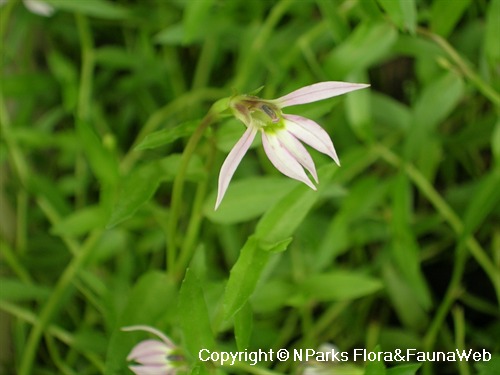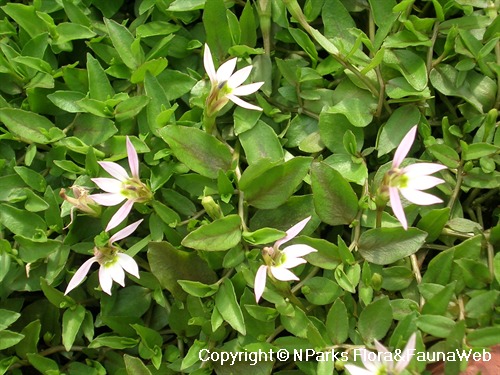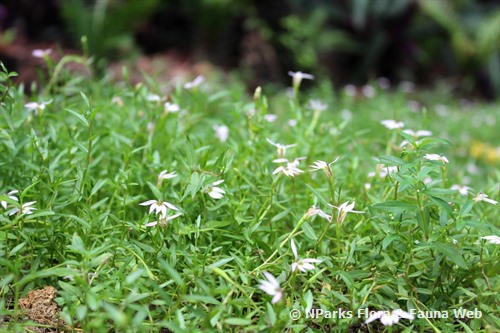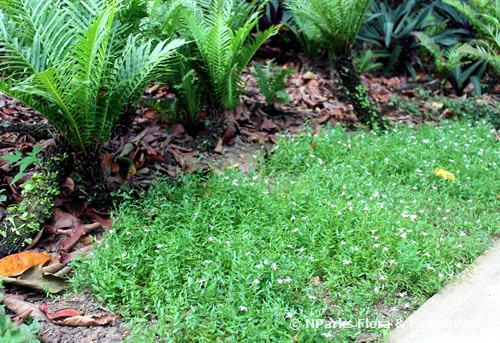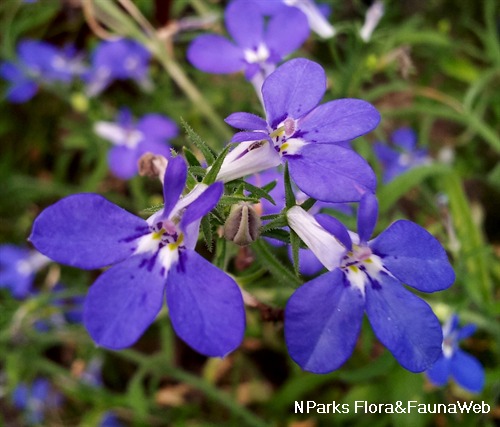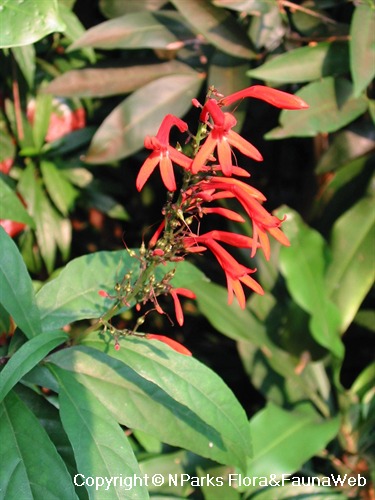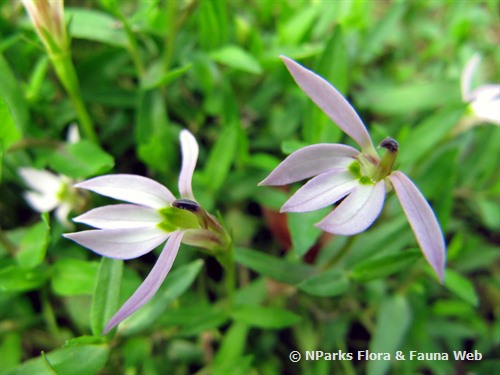
Back
Lobelia chinensis
| Family Name: | Campanulaceae |
| Common Name: | Creeping Lobelia, Chinese Lobelia, 半边莲 |
Name
Classifications and Characteristics
| Plant Division | Angiosperms (Flowering Seed Plants) (Dicotyledon) |
|---|---|
| Plant Growth Form | Shrub |
| Lifespan (in Singapore) | Perennial |
| Mode of Nutrition | Autotrophic |
Biogeography
| Native Distribution | Japan, Korea, China, Nepal, Bangladesh, India, Sri Lanka, Southeast Asia and Malaysia. |
|---|---|
| Native Habitat | Terrestrial |
| Local Conservation Status | Non-native (Spontaneous (Naturalised)) |
Description and Ethnobotany
| Growth Form | It is a creeping and low growing herbaceous plant which gives an attractive ground cover. It grows up to 0.5 to 1 m tall but can spread up to 11 m wide. |
|---|---|
| Foliage | Foliage are green, narrowly elliptic or lanceolate, measuring up to 2 cm long and 7 mm wide, base rounded, obtuse, or broadly cuneate, apex acute or acuminate, margin entire or sometimes serrate at upper part; alternate, sessile or petiole (1mm). |
| Stems | Creeping, slender stems which are glabrous. |
| Flowers | Flowers are solitary, pale pink to white, measuring 3 cm across, axillary at the upper leaves. |
| Fruit | Capsule, obconic (conical shape, with the pointed end attached to the stalk), measures 6 -7 mm. |
| Habitat | Grows well on paddy fields, moist meadows and stream banks. |
| Etymology | The genus Lobelia honours Matthias de l'Obel, (1538 - 1616), a French botanist and herbalist. The specific epithet chinensis means from China, which refers to its native habitat. |
| Ethnobotanical Uses | Others: Lobelia has both antiseptic and antitoxic properties.It has a cooling effect and can be used to treat snake bites. It is often mixed with other medicinal herb to use as a ointment. |
Landscaping Features
| Landscaping | Suitable as ground cover around ponds, along the streams and bog gardens. Can be used as attractive hanging plants in pots. |
|---|---|
| Desirable Plant Features | Ornamental Flowers |
| Landscape Uses | Marsh / Bog, Groundcover, Suitable for Hanging Baskets |
Fauna, Pollination and Dispersal
| Fauna Pollination Dispersal Associated Fauna | Bird-Attracting (Flowers), Butterfly-Attracting (Flower Nectar) |
|---|
Plant Care and Propagation
| Light Preference | Semi-Shade, Full Sun |
|---|---|
| Water Preference | Moderate Water |
| Rootzone Tolerance | Moist Soils, Well-Drained Soils |
Foliar
| Foliage Retention | Evergreen |
|---|---|
| Mature Foliage Colour(s) | Green |
| Mature Foliage Texture(s) | Smooth |
| Foliar Shape(s) | Non-Palm Foliage (Lanceolate) |
| Foliar Margin | Entire |
| Foliar Apex - Tip | Acute, Acuminate |
| Foliar Base | Cuneate, Rounded / Obtuse |
| Leaf Area Index (LAI) for Green Plot Ratio | 4.5 (Shrub & Groundcover - Dicot) |
Floral (Angiosperm)
| Flower Colour(s) | Pink, White |
|---|---|
| Flower Grouping | Solitary |
| Flower Location | Axillary |
Fruit, Seed and Spore
| Fruit Type | Dehiscent Dry Fruit , Capsule |
| Seed Description | Seeds are compressed, broadly elliptical in shape and pitted. |
|---|
Image Repository
Others
| Master ID | 906 |
|---|---|
| Species ID | 2200 |
| Flora Disclaimer | The information in this website has been compiled from reliable sources, such as reference works on medicinal plants. It is not a substitute for medical advice or treatment and NParks does not purport to provide any medical advice. Readers should always consult his/her physician before using or consuming a plant for medicinal purposes. |

